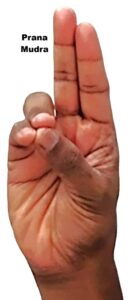Mahaprana Mudra
Introduction
Mahaprana Mudra is a powerful therapeutic and pranic hand gesture that activates the vital life force (Prana Shakti). In yogic philosophy, Mahaprana refers to the universal vital energy that sustains life. This mudra is practiced to strengthen the lungs, expand breath capacity, improve energy circulation, and enhance immunity.
It is often taught in Pranayama practices and in Mudra Therapy to boost vitality, particularly for those with weak respiratory function, chronic fatigue, or low immunity.
Meaning
Maha = Great, supreme.
Prana = Vital life force, breath, energy.
Mudra = Gesture or psychic seal.
Thus, Mahaprana Mudra means the great gesture of vital energy, symbolizing the awakening and channeling of universal pranic force within the body.
How to Perform (Practice)
Sit in a comfortable meditation posture (Sukhasana, Padmasana, or Vajrasana) with spine erect.
Place both hands on the thighs.
Hand formation:
Join the tips of the thumb, ring finger, and little finger together.
Keep the index and middle fingers extended straight and close together.
Rest the hands on thighs with palms facing upward.
Close the eyes, relax, and breathe slowly and deeply.
Focus on the breath moving through the nostrils and feel energy spreading throughout the body.
Visualize white light or vital energy filling the lungs and energizing every cell.
Benefits
Physical Benefits
Strengthens lungs and improves oxygen exchange.
Useful for respiratory problems like asthma, bronchitis, breathlessness.
Increases lung capacity and efficiency.
Boosts immune system and resistance to infections.
Improves circulation and overall stamina.
Energetic Benefits
Activates and harmonizes Prana Vayu (upward-moving life energy).
Enhances flow of prana through all nadis (energy channels).
Awakens Anahata Chakra (heart center) and strengthens vitality.
Reduces pranic blockages that cause fatigue and weakness.
Mental & Emotional Benefits
Relieves stress, anxiety, and nervousness.
Promotes calmness, clarity, and inner strength.
Increases confidence, motivation, and positive energy.
Contraindications
Should be avoided in cases of:
Severe hyperventilation disorders.
Very high blood pressure.
Acute infections with fever.
Should not be forced in people with serious cardiac conditions without supervision.
Anatomy & Physiology
System influenced: Primarily respiratory, circulatory, and autonomic nervous system.
Improves alveolar oxygen exchange in lungs.
Enhances vagal stimulation → balances heart rate and blood pressure.
Increases parasympathetic activity, promoting relaxation.
Indirectly stimulates immune responses.
Kinesiology
Finger contact:
Thumb = fire element (Agni, energy).
Ring finger = earth element (Prithvi, stability).
Little finger = water element (Jala, fluidity).
Index & middle fingers extended = space & air elements remain open.
This combination enhances pranic balance and lung expansion.
Neurology
Stimulates phrenic nerve pathways controlling diaphragm.
Enhances vagus nerve activity → reduces stress, calms mind.
Improves neural regulation of respiration and autonomic balance.
Strengthens the brain–lung connection, reducing psychosomatic breathing issues.
Duration of Practice
10–15 minutes per session, 2–3 times daily.
Can also be combined with Pranayama practices (e.g., Anulom Vilom, Bhramari).
Regular practice for 4–6 weeks gives measurable improvement in breath and vitality.
Counter Mudra
To balance overstimulation or excess heat from Mahaprana Mudra, practice:
Prithvi Mudra → for grounding and stability.
Apana Mudra → to release excess energy and aid elimination.
Chin Mudra → for calming and meditation.
Conclusion
Mahaprana Mudra is a vital energy-enhancing practice that strengthens the lungs, boosts immunity, and harmonizes pranic flow. It supports respiratory health, reduces fatigue, and awakens inner vitality. As the “great gesture of prana,” it connects individual energy with universal energy, promoting overall well-being and spiritual balance. Regular practice with mindful breathing enhances both physical health and mental calmness.
FAQ
Q1. Can Mahaprana Mudra cure asthma?
It supports respiratory function and reduces symptoms, but should be used as a complementary therapy, not a cure.
Q2. Can it be practiced during illness?
Yes, in mild respiratory issues, but avoid during high fever or acute infection.
Q3. How long before results are felt?
Improvement in energy and breathing may be felt within 1–2 weeks of daily practice.
Q4. Is it safe for children?
Yes, children with weak immunity or asthma can practice gently under guidance.
Q5. Can it be combined with Pranayama?
Yes, it works excellently with deep breathing, Anulom Vilom, or Bhramari.
References
Gertrud Hirschi – Mudras: Yoga in Your Hands.
K. S. Joshi – Mudras in Yoga.
Swami Satyananda Saraswati – Asana, Pranayama, Mudra, Bandha.
Dr. Dhirendra Brahmachari – Yogic Therapy.
Research on mudras and autonomic nervous system regulation.

